AMD’s Radeon HD 6870 & 6850: Renewing Competition in the Mid-Range Market
by Ryan Smith on October 21, 2010 10:08 PM ESTLast but not least in our look at AMD’s new Radeon 6800 series is our look at power consumption, GPU temperatures, and the amount of noise generated. With efficiency being one of the major design goals for Barts, AMD stands to gain a lot of ground here compared to the 5800 series for only a minor drop in performance.
Looking quickly at the voltages of the 6800 series, we have 4 samples – 2 each of the 6870, and 2 each of the 6850. Both of our 6870 cards have an idle voltage of 0.945v and a load voltage of 1.172v, and seeing as how they’re both based on AMD’s reference design this is what we would expect for a design that is based around a single VID.
However our 6850 results, which include a non-reference card in the form of XFX’s customized 6850, are much more interesting. While our reference 6850 has a load voltage of 1.094v, our XFX card reports a load voltage of 1.148v. We’ll be taking a look at the XFX 6850 in-depth next week in our 6850 roundup, but for now this leaves us with the question of whether AMD is using variable VIDs, or if XFX is purposely setting theirs higher for overclocking purposes.
| Radeon HD 6800 Series Load Voltage | |||||
| Ref 6870 | XFX 6870 | Ref 6850 | XFX 6850 | ||
| 1.172v | 1.172v | 1.094v | 1.148v | ||
Finally our EVGA GTX 460 1GB FTW card has a VID of 0.975v, which compared to all the other GTX 460 cards we’ve tested thus far makes it quite notable. This is lower than any of those other cards by 0.012v, a property we believe is necessary to sell such a heavily overclocked card without causing a similarly large rise in power/heat/noise. It’s also for this reason that we question whether NVIDIA could actually supply suitable GF104 GPUs in high volumes, as GPUs capable of running at this voltage are likely coming from the cream of the crop for NVIDIA.
For our tests, please note that we do not have a pair of reference 6850s. For our second 6850 we are using XFX’s customized 6850 card, which means our results will undoubtedly differ from what a pair of true reference cards would do. However as the 6850 reference design will not be widely available this is less important than it sounds.
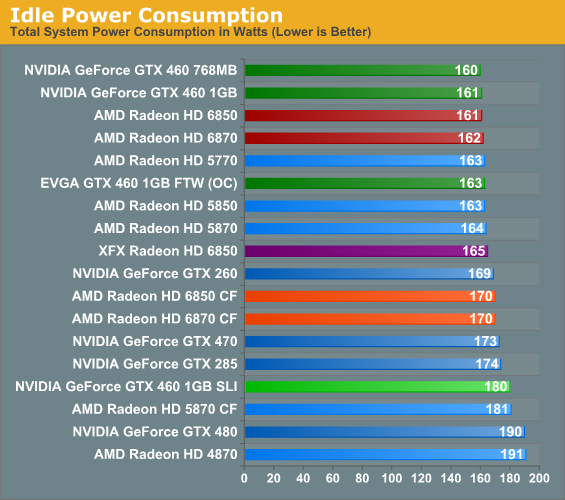
As always we start our look at power/temp/noise with our look at idle power. Because we use a 1200W PSU in our GPU test rig our PSU efficiency at idle is quite low, leading to the suppression of the actual difference between cards. But even with this kind of suppression it’s still possible to pick out what cards have a lower idle power draw, as the best cards will still result in a total system power draw that’s at least a couple of watts lower.
AMD’s official specs call for the 6800 series to have a lower idle power draw than the 5800 series, and while we can’t account for all 8 watts we do manage to shave a couple of watts off compared to our 5800 series cards. The Crossfire results are even more impressive, with the 6870CF drawing 11W less than the 5870CF.
Compared to the 6800 series the GeForce GTX 460 768MB does manage to hang on to top honor here for a single card by a watt, however in SLI our 1GB cards do worse than our 6800 series cards by 10W.
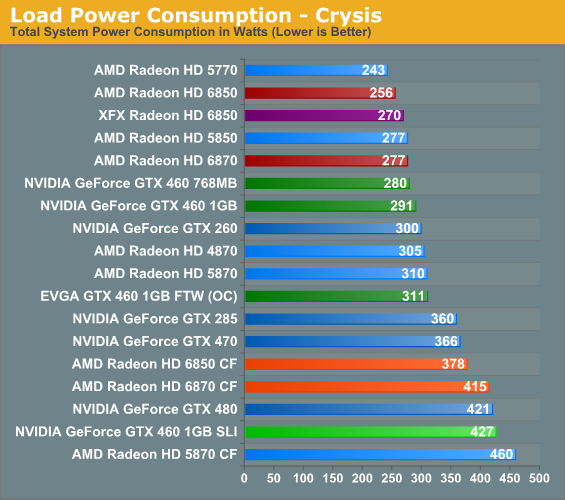
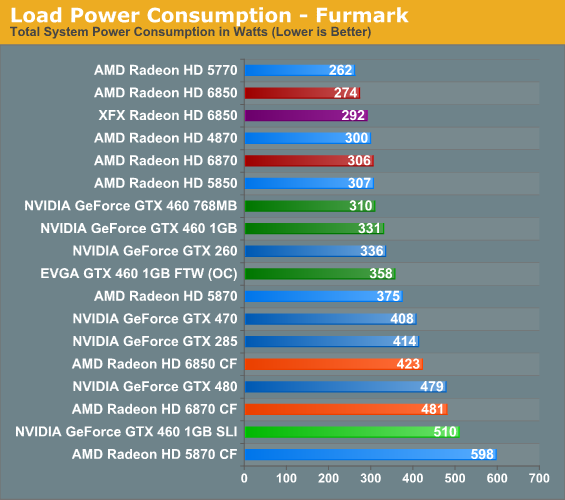
Looking at load power consumption it’s clear from the start that AMD’s efficiency gains are going to pay off here. On the latest iteration of our power consumption chart the 6850 underconsumes even the already conservative 5850 by 20W under Crysis and 25W under FurMark, showcasing how AMD was able to reduce their power consumption by a significant amount while giving up much less in the way of performance.
Compared to the 6800 series NVIDIA does notably worse here, with all of the GTX 460 cards pulling down more power than the 6870 and the GTX 470 being in a league of its own. While NVIDIA was competitive with Cypress on power, they’re not in a position to match Barts. They can deliver Barts-like performance (and then some), but they have to consume more power to do it.
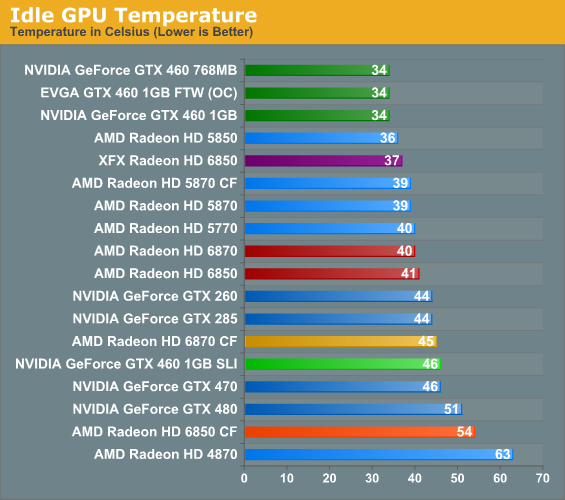
Up next is our look at GPU temperatures, starting with idle temps. As we mentioned in our GTX 460 review, NVIDIA ended up producing a very effective reference cooler for the GTX 460, utilizing an open-air design that by dissipating air inside and outside of the case is capable of reaching temperatures fully exhausting coolers can’t match. As a result all of the GTX 460 cards top our charts here.
Prior to the GTX 460 series this is a metric the 5850 always did well in, so we had expected a similar performance from the 6850, only to leave disappointed. What we’re ultimately looking at is a matter of the quality of the cooler: the 6850 may consume less power than the 5850 at idle, but it packs a weaker cooler overall, allowing it to approach these temperatures. For a gaming card such as the 6800 series idle temperatures are almost entirely superficial once we get below 50C, but even so this tells us something about the 6850 reference cooler.
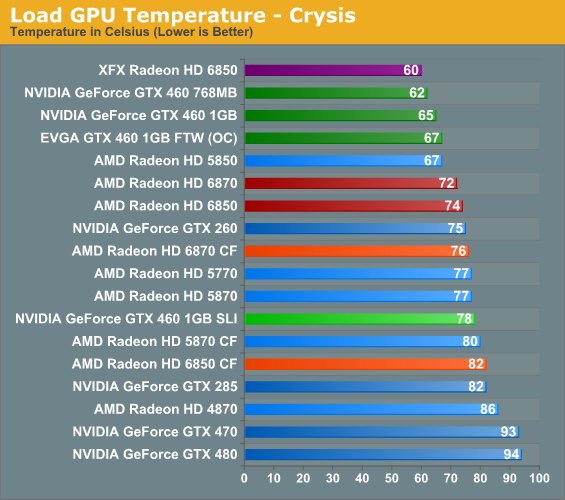
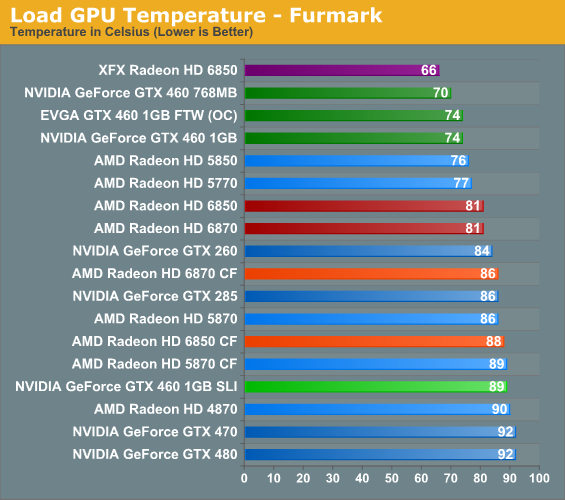
Thanks to the GTX 460’s open-air cooler, all of our GTX 460 cards top our temperature chart even with their higher power consumption. The trade-off is that all of these cards require a well-ventilated case, while the Radeon 5800 and 6800 series will tolerate much poorer cases so long as there’s enough ventilation for the card to pull in air in the first place.
As was the case with idle temperatures, the reference 6850 ends up doing worse than the 5850 here thanks to its less effective cooler; however the 6870 ends up doing better than both the 6850 and 5870 due to its more effective cooler and its lower power consumption compared to the 5870. While these cards can’t quite touch the GTX 460 series, we’re still looking at some of the coolest cards among our current benchmark suite.
Meanwhile our XFX 6850 ends up doing the best out of all of our cards here, however this will come at a cost of more noise. We'll touch on this more next week in our 6850 roundup.
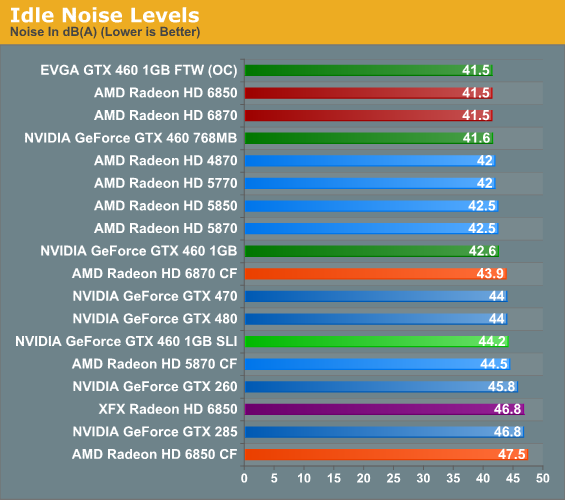
Last but not least is idle noise, which isn’t much of a story with modern cards. With the exception of the GTX 470/480, the latest GeForce and Radeon cards are both capable of running up against the noise floor of our testing environment.
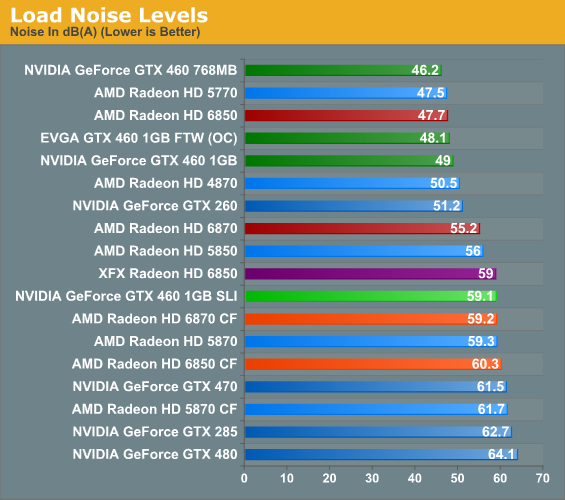
Under load we once again see an NVIDIA GTX 460 card top the chart thanks to its open-air design. This is followed very closely however by the Radeon 6850, which at 47.7dB is our third-quietest card and finally showing off the advantages of the tradeoffs AMD made with the reference cooler. The 6850 may not be as cool as the 5850, but it’s quite a bit quieter. As for the XFX card, this is where XFX has to pay the piper, as their 6850 card ends up being as loud as a 5870 in exchange for their lower temperatures.
Meanwhile the 6870 ends up being quite a bit louder than both the GTX 460 series and the 6850, coming in at 55.2dB. This is a definite leg-up compared to the 5870 and nicely cements the fact that the 6870 is intended to be the 5850’s replacement, but it means the GTX 460 series spoils the results here. Once custom-design vendor cards come out for the 6870, I suspect we’re going to see someone quickly sell a 6870 with a less aggressive cooler, which for the costs of higher temperatures would afford less noise.










197 Comments
View All Comments
Setsunayaki - Friday, October 22, 2010 - link
There was a graph where a 4XXX series card beat the 6XXX series card...There were many where the 5XXX series was higher...Tesellation performance is higher on the 460 GTX and SLI scales better than crossfire...What the tesselation performance graph really means is that if you were to take an 460 GTX and 6870 and turn off tesselation and play a game....the 6870 gets a higher framerate, but if you turn on Tesselation on Both cards and go full force with Tesselation and other features (considering that Nvidia has support for PhysX and most games now have some physics implementation)...the outcome shows the 6870 taking such a performance hit that as far as framerates go....a 460 actually matches it or beats it outright.
What ATI/AMD really needs to work on is Integrating more technologies on its card to actually have more options during a game. No physics processing, Just an optimization on AA and AF...and tesselation performance that doesn't come close to a 460, along with horrible linux support...I really wonder and hope that their flagship card shows something steller....
Not to argue against it, but for the deserving ATI/AMD fans who have stuck with them over the years. ^_^
Alilsneaky - Friday, October 22, 2010 - link
Prices are high for both in my country (Belgium).199 Euro for the 6850 and 279 euro (in the cheaper shops, upto 350 in others) for the 6870.
Very bland release for us, nothing to get excited about at that price point.
I also take offense to the naming scheme, why pick a name that will inevitable deceive many people into buying a sidegrade.
Pastuch - Friday, October 22, 2010 - link
There was not nearly enough discussion on DTS HD MA and TrueHD pass through in this article. Gaming is 50% of the reason to upgrade, the rest of my focus is HTPC use. Please compare the GTX 460 vs the 6870 regarding bit-streaming, video quality and hardware decoding.Thanks.
P.S. Nvidia usually does a pathetic job on anything not related to gaming.
Scootiep7 - Friday, October 22, 2010 - link
I think you guys are a little off on calling the 6870 the $200 price point King. The cheapest retail for the card right now is $239.99 for any model and then you have to add in another $5~10 for shipping. That sticks it at $245 - $250. That's no where near the $200 price point. And with most GTX 460 1GBs sitting at about $170 - $190 (w/ shipping), this card is not competing with them on price at all. Maybe in a few months if prices drop, but not now. It's more in the GTX 470 range and that is much tougher competition. I'm sorry, but the 6870 is NOT the $200 price point King. It's not even close.Lolimaster - Sunday, October 24, 2010 - link
HD6850 offers better performance tha 460 1GBHD6850 costs $175
HD6870 kill both of them, and also 470 performance/power consumption (80w less)
Scootiep7 - Sunday, October 24, 2010 - link
Ok, I'm sorry, but I have to laugh at this. Where the hell are you finding a 6850 for $175. The cheapest ANYWHERE is $199 and you still have to factor in #8ish shipping. Re-read my post and realize that the prices I quoted are accurate and you're still looking at a $30 price difference between the 6850 and the 460 1gb. Yes the performance is better, but it's not amazingly better and I don't think it justifies it. Hey, I'm all for the red team this time around. I picked up a 5770 which is an amazing bang for the buck card. I'm just saying that calling the 6870 or the 6850 the new $200 price point king is wrong. Too many variables.orthancstone - Friday, October 22, 2010 - link
I'm especially pleased to see the 4870 included in some benchmarks. As someone who owns one and who was never impressed with the performance boost/cost ratio of the 58/59xx lines, I've been wondering how the 6xxx line would compare to the two generation old stuff. I'd love to see it included in the third party 6xxx reviews.Edison5do - Friday, October 22, 2010 - link
As a owner of a HD 4850 was planning to get an HD 5770 but at this point it looks like HD 6850 looks like a better option with a few more bucks.. or wait to see if the HD 5770 will drop price a little more....Sando_UK - Friday, October 22, 2010 - link
Anandtech is one of my favourite review sites and it's a real shame to see what's happened here. I don't know the reasons why you guys needed to include the 460 OC in this review (does sound like a fine card btw, but this wasn't the place for it) - can't see any reason this wouldn't have been much better compared in a separate article. The fact Tom's hardware did a very similar thing makes the whole thing fishy...New generations/architectures don't come along very often and deserve proper comparison and coverage - I'm not an AMD or Nvidia fanboi (happy to go with whichever is best price/performance/extras at the time) but we rely on you guys to give us the facts on a level playing field. I'm sure you have in this case, but even the suggestion of impropriety damages you (extremely good) reputation, and I think it's something you should really try to avoid in the future - be it AMD or Nvidia reviews.
Otherwise, thanks for all your hard work.
Natfly - Friday, October 22, 2010 - link
It's sad to say, but this review fucking sucks. UVD and the display controller have been overhauled but you make no mention of any of the changes. Are there still only 2 RAMDAC clocks? Or can you now use passive DP converters while using both of both DVI ports?And including an OC'd card because nVidia pushed you into it? Way to take a shot to your credibility. And no mention of its clocks or price... AND no overclocking numbers for these new cards when you are specifically comparing it to an OC'd card? I mean wtf, this review is not up to previous Anandtech standards.